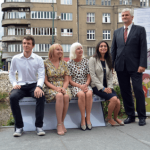Despite its flaws, nobody can deny that Croatia is an exceptionally innovative country which seems to breed incredible talent across all possible fields, from sport to science and everything in between. Ever fancied flying over Croatia without ever leaving the comfort of your armchair? Now you can, thanks to the successful combination of tourism and VR by the talented Sveb family from Zagreb.
As Lea Balenovic/Novac writes on the 1st of March, 2020, the Sveb family have designed something rather remarkable indeed.
I’m in a hurry to board. At the entrance to the cabin, two flight attendants, Lidija and Marta, await me and point me to my VIP seat in the first class section of the aircraft, where they provide me with the safety instructions. The captain speaks to me and we take off.
But, in fact, I’m not in an aircraft cabin or flying over Croatia. In Zagreb’s popular Radiceva street, I’m sitting in an armchair and watching footage of Osijek, Zadar, Plitvice Lakes and Pula. But I don’t have the slightest feeling that I haven’t moved from my hometown and I have VR glasses on my head. I really think I’m flying over the walls of Dubrovnik. I look up, I see the sky. I look down, I see the sea.
The footage of the flight over Croatia isn’t the usual type we usually come across on YouTube or on television, as it was filmed in 360 degrees. With a turn of my head, I can see everything around me, and virtual reality somehow loses any sense of being virtual. Flying over Croatia from the comfort of your own armchair is an option that has been being provided for the last two weeks in Zagreb, with Lidija and Marta at the beginning of the story, as well as Robert. The Sveb family that has been being developed for two years now.
”We’d have thrown this out onto the market before if there were no mistakes,” laughs Robert Sveb, the original creator of the idea of connecting virtual reality and tourism. The Sveb family had no one from to learn when it came to how to offer tourists something new with the help of advanced technology, and the only thing left to do was learn by good old trial and error.
”First, we shot everything with the wrong camera, so we had to throw the shots away, buy a new camera and start all over again. But then it was autumn, and it made no sense to send the drones up because of the bad weather. So we waited until spring,” the Sveb family remembers.
In the meantime, they visited interntional travel fairs and attended conferences, acquired VR glasses, written text to accompany the footage (because it doesn’t mean too much if we don’t know what we’re looking at), translated it into foreign languages, developed our own glasses control software, designed a marketing campaign, and created a website. And then re-recorded everything in 8K resolution (and the glasses are 4K).
For that, of course, they had to get all the shooting licenses again, hire drone operators, hire boats and skippers, and travel across Croatia. But all of this was easier for the Sveb family than finding space in downtown Zagreb.
”That was one of our biggest problems, we really struggled with that. We wanted to be easily accessible to tourists, that is, to be in the very heart of Zagreb. We applied to various state and city tenders, but since we were financing everything ourselves, we couldn’t afford it. So re-recording was less of a hassle than finding space,” Lidia Sveb explained. Still, these are good times when you know you have a good idea that no one in the world has figured it out.
”I worked for a major media outlet outside of Croatia, which aspires to be the voice of people from the third world. In addition, it works closely with various institutes and faculties conducting research on new technologies and digital media, and so virtual reality emerged on the horizon. Research has shown that storytelling in VR fosters eight times more empathy than classic storytelling does, even when compared to ordinary videos,” explained Robert Sveb.
“I thought it would be good to create a newsroom that would deal with difficult human stories using VR technology and I was thrilled with the results,” he added. When he returned to Croatia, he simply had to try something with “this new technology”.
The combination of VR and tourism was simply more viable and cheaper than other ideas that came to the mind of this experienced manager. In addition, tourism in Croatia is still an enormous economic branch on which one can quite easily live.
His wife, Lidija, and daughter, Marta, thought this idea was excellent, and when he told them at his desk what had happened, it didn’t take long for them to join in with the business development as the Sveb family business.
”I have a degree in psychology, and I’ve always been most interested in developing creativity. People learn best when they’re part of something, when they can see, hear, and simply feel at the same time, and VR provides that. In addition to flying over Croatia, you can also listen to an educational story about it, which proved to be very useful,” says Marta Sveb.
HRVR, as they called their boutique, has so far been visited by Americans, Germans, Brits, Argentines and, of course, other Croats.
”Oh, wow, I didn’t know Croatia was so beautiful,” go the typical reactions from foreigners.
Croats, however, react slightly differently, they have less focus on the beauty of their homeland, but are instead more focused on the technology and the unprecedented perspective of Croatian attractions.
”One visitor told us that she wanted to take her mobile phone and record in the middle of the flight, but then she remembered that the experience wasn’t actually real.
”It’s virtual, but there is nothing more realistic,” claims the Sveb family, who are the very first in the entire world to offer such a tour (or at least it was the first to actually achieve it). Lidija told us that recently such a tour as the ”future of tourism” was mentioned in Like, a travel magazine that comes out once a month.
”A PhD student said that there are tours where tourists wear VR glasses and when they arrive at a certain location, animations appear that bring history to life for the tourists, and said that in the future, people will be able to see Earth from their airmchairs. Obviously, we have already brought the future to Zagreb,” Lidija Sveb says proudly.
She is otherwise an entrepreneur with many years of experience working with people. Therefore, this role simply belonged to her.
The flight lasts a mere seven minutes, and each and every minute is carefully thought out.
”Studies have shown that after seven minutes of virtual reality, the brain becomes accustomed to it and that there is a possibility that when people take off their glasses off later, they become unwell, we didn’t want that to happen at all,” explained Robert Sveb.
The Sveb family business is based on exhaustive analysis, and before everything else, they conducted market research to see if they had a chance to be able to start making money from it. So they came to a decision on the price of the experience they were selling. A flight over Croatia costs 80 kuna.
There are twelve locations that have been selected according to attendance, and the six foreign languages where you can hear the story of Croatia and its beauty: English, German, French, Italian, Spanish and Korean, are the result of statistics on the number of visitors who have been visiting the Croatian capital for the last three years. Translators have translated the text into these languages, and it is spoken by robots. The Croatian language is the only pre-recorded text, and the remaining languages are a product of artificial intelligence.
”The text is in the cloud, and robots speak it over and over again, constantly improving, and their speech becomes human, that is, it ceases to be monotonous and begins to truly tell the story,” Robert says.
New languages are already in the pipeline and their heads are already full of new ideas.
Make sure to follow our Made in Croatia and travel pages for more.









